|
|
|
|
|
Agent Orange' was the name of a chemical herbicide (that came in orange containers) which United States forces sprayed extensively from 1962 to 1971 in order to kill vegetation and greenery in the Vietnamese jungle and to enable them to infiltrate Viet Cong hideouts hidden in the dense terrain. The toxic Agent Orange eliminated forest cover for North Vietnamese and Viet Cong troops, and the crops that might be used to feed them. What was Agent Orange? Agent Orange was a highly poisonous herbicide used as a spray for foliage destruction (defoliation) and crop destruction, by US forces during the Vietnam War What was Agent Orange used for? Agent Orange was used for destroying the almost impenetrable dense terrain and the vital trails used by the North Vietnamese forces and Viet Cong who fought the Vietnam War use guerilla tactics. Where were the effects of Agent Orange? The effects of Agent Orange were to destroy the jungle trees and plants of Vietnam but the effects of exposure to Agent Orange led to numerous serious ailments, physical deformities, birth defects, cancers and mental disorders. Facts about
Agent Orange The communist North Vietnamese and their guerilla forces called the Viet Cong led by Ho Chi Minh fought throughout the Vietnam War to oust the President Ngo Dinh Diem and his American backers from South Vietnam. The Americans fought a hi-tech war, using B52 bombers, helicopters, napalm and defoliants such as Agent Orange to combat the guerrilla tactics of the communists. The communists successfully used guerilla warfare tactics fighting in the dense, impenetrable jungles of the Vietnam terrain. The dense canopies of trees made it almost impossible for the pilots of high-flying, high-speed jets, and the low-flying helicopters, to see and destroy targets, such as those along the Ho Chi Minh Trail and their intricate interconnecting tunnel systems. The communists ensured that they kept the advantage of the dense terrain by ensuring that their troops and vehicles were kept well hidden. They employed various camouflage techniques to maintain coverage, such as weaving together treetops to hide what lay beneath. Trees and plants that were cut down during the North Vietnamese and Viet Cong operations were re-planted to maintain coverage. The American response to combating the problem of the Vietnam terrain was to employ chemical warfare and used defoliants, the most famous being Agent Orange, to kill off the greenery that gave cover to the troops and and vehicles used by the North Vietnamese and the Viet Cong and destroyed the crops and contaminated the food that might be used to feed them. The nickname 'Agent Orange' was given due to the orange stripe painted on the 55-gallon drums in which the chemical was stored. Agent Orange was developed for the U.S. offensive biological warfare program at the U.S. Army Biological Warfare Laboratories (USBWL) in Maryland The environmental and medical effects of Agent Orange were not fully evaluated as to their danger and impact on people and the environment. The name 'Rainbow Herbicides' was given to the group of "tactical use" chemicals used by the United States military during the Vietnam War. Agent Orange was one of the “Rainbow Herbicides” that were used, along with Agents White, Green, Purple, Pink and Blue. The collection of Rainbow Herbicides damaged the ecosystems and cultivated lands of Vietnam, and led to buildup of dioxin in the food chain. It is estimated that about 4.8 million people were affected. Dioxin is one of the components and a toxic contaminant in Agent Orange. Dioxin can enter the human body from food, the vapors and from physical contact. Dioxin is not water soluble, nor is it absorbed by plants. Dioxin can attach to fine soil particles which are then carried by water downstream and settle as sediment in the bottoms of lakes and ponds. Dioxin can then continue to adversely affect people who eat dioxin-contaminated fish, shell fish and water fowl. The U.S. program of defoliation, codenamed Operation Ranch Hand operated from from 1961 to 1972 during which time more than 19 million gallons of herbicides were sprayed over 4.5 million acres of land in Vietnam. The effects of Agent Orange have been in the form of illnesses on the Vietnamese people and on the environment of Vietnam in soil and water contamination. US troops also suffered from the effects of contamination with the chemical. 2.6 million US military served in Vietnam and an additional 514,000 men served in waters off the coast of Vietnam in the Blue Water Navy, while close to 300,000 served elsewhere in Southeast Asia including Laos, Cambodia, and Thailand. US Soldiers exposed to Agent Orange and other Rainbow Herbicides in Vietnam began to report various short term illnesses including Type-2 diabetes, skin irritations and psychological symptoms. As time passed an increasing number of Vietnam veterans reported long term health effects, which led to several lawsuits against the U.S. government and the manufacturers of the chemical Dioxin. Settlements in court are over $240 million. A 1984 class-action lawsuit against Agent Orange’s manufacturers, Monsanto and Dow Chemical, resulted in a nearly $200 million Agent Orange Settlement Fund. In 1991, President George H. Bush signed the Agent Orange Act, which mandated that some diseases associated with defoliants in relation to veterans with conditions related to their exposure to Agent Orange should be treated as the result of wartime service Vietnam still remains heavily contaminated by dioxin-like compounds, which are classified as Persistent Organic Pollutants (POPs) defined as chemical substances that persist in the environment, bioaccumulation through the food web, and pose a risk of causing adverse effects to the environment and human health. |
| US American History |
| 1945-1993: Cold War Era |
|
|
|
|
|
First Published2016-04-19 | |||
|
Updated 2018-01-01 |
Publisher
Siteseen Limited
| ||
|
|

